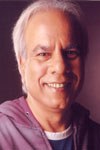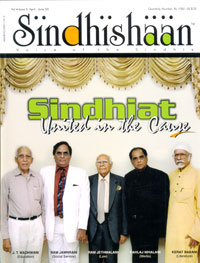Hurts & Wounds -
50 years of Sindhiat in India
By Arun Babani

Ten lakh Sindhis migrated to India from Sindh in 1947. Being a predominantly business community, you can as well say, 9 lakh 99 thousand setup shops and began rolling papads. The remaining 1000 Sindhi refugees decided to ‘do something’ for the community, and so a helter skelter movement which has loosely been termed ‘Sindhiat Hulchul’ came into being. These 1000 Sindhis - half the number being writers, some teachers, and a few from services, essentially a middle class grouping, came together and formed Sabhas and Circles, and jointly called themselves ‘Sindhiat ja Sipahi’.
History has a way of being written and someday a history of Sindhiat movement will well be recorded. This is just a personal review of events and people that shaped this movement for the last five decades.
The very first task facing these grand thousand was to rehabilitate themselves as well as the community. A formidable task involving land, ration and a meagre refugee status. Schools to be set up in shanty camps; urinals to be built with hands; queues to be maintained at the refugee distribution systems. Then came the rush for jobs, shops, and an intense fight for survival. A painful chapter in the history of a Sindhi’s journey in life which, today, half a century later is still alive and haunting like a deadly nightmare. On the political front, a struggle to incorporate the Sindhi language into the Indian Constitution, along with a demand for a separate state for the displaced Sindhis took shape in the early 50s and 60s. The grand thousand took to streets of Indian towns. Historically this period was the beginning of a united and common stand point with regards to goals and vision of Sindhiat: Sindhis need to be rehabilitated; Sindhis demand a fair deal; Sindhis want back all that they have lost due to Partition; Sindhis need to be acknowledged and appreciated for their immense sacrifice.
A united and common goal of a thousand Sindhis was like a thundering roar. And they were followed by the Sindhi Junta in multitudes wherever they went. An important point of this period is that throughout 50s, 60s, 70s and 80s All India Sindhi Sammelans and Melas were organized and were attended enmass by those thirsty for Sindh and Sindhis. During this period Sindhiat was a more or less unified and passionate action. Ram Punjwani led the movement of Sindhi folk music, and later founded the Sita Sindhu Bhavan in Mumbai. Trimurti of Malhi, Kirat and Uttam took the movement to all corners of India and were ready to die for the cause. In other parts of India great souls like Bhai Pratap were setting up Gandhidham, and these grand thousand dreamt big and whatever they dreamt just seemed to materialize out of the miraculous thin air. A Sindhi Academy in each state; a Sindhi Sabha on an All India basis; a Sindhi township; a few Sindhi theatre groups; Sindhi schools and colleges; and many Sindhi newspapers, magazines and periodicals!
And then the dreamers grew old and infirm. Somewhere around the 90s their dreams had to be transferred to the younger shoulders. The grand thousand had been waiting for another thousand or two younger minds to join them. THAT DID NOT HAPPEN. Moreover soon these grand thousand started seeing their private dreams, quite at variance with each other. And then there were conflicting dreams, conflicting visions and conflicting issues. It was as if for a dying mother too many doctors with their doctorates had been called, each with his own therapy, his own medicine. The dying mother kept on getting weaker by the day but this bunch of doctors kept fighting among themselves about the cause and cure. This is the story of Sindhiat of 55 years. Today Sindhi unity is being discussed in Sindhi magazines; the complete absence of Sindhi youth is being discussed at various fora and gatherings; the absolute lack of direction of Sindhiat is being discussed at seminars and the ego clashes and back biting are discussed in editorials. What started as a love for the motherland and a passion for Sindhu Sabhyata has today turned into a free for all circus where every Sindhi leader makes his own sense out of the word Sindhiat and every writer his own prescription for its survival.
What went wrong? The ten lakh of 1947 have now grown to fifty lakhs. Almost all of them are now beyond the issue of rehabilitation and survival, and many of them among the top citizens of almost 200 countries where Sindhis have a significant presence. But the grand thousand or whoever remains from them today don’t consider the project complete. In fact there are many hurts and wounds they have picked on the way. The most common cries in the wilderness of the Sindhi leaders are:
1) Lack of unity among Sindhis has replaced the united action for a common cause of Sindhiat witnessed in the earlier decades and we see most Sindhi leaders running here and there for awards, recognitions and receptions-the entire scene is filled with conflict and controversy.
2) This leads to a lack of unified vision of the future Sindhi projects. The priorities are lost and a diffuse action varied and at variance with each other is available.
3) Lack of young blood donors for the dying mother. Because of the moral and ethical environment of today the youth cannot see anything beyond sex and money. This is the case with youth in general and the Sindhi youth is no exception. The young people can feel proud for their car, for their jeans, but “Abano Warso” is beyond their grasp. Nor can they have any use for such an outdated product.
4) The formidable Sindhi ego is a much wounded and bruised ego. Everyone has gone through so much pain and humiliation. This ego cannot afford to practice tolerance and team work. It just has to assert its own achievements and ignore others. This just seems to be in the very nature of Sindhi competitive spirit.
Let each one of us Sindhis ask ourselves some questions. What went wrong? What did I do? What can I do now to strengthen myself and my community? Let each of us, as the inheritors of the Indus Valley, ask ourselves in the total secrecy of our soul and look at our face in the mirror of our being and pray.
A new prayer is needed for the Sindhi community. A prayer that you and I can feel one with - a prayer that can breathe life into our dying mother, our shattered dream and our lost pride.
Upanishads have a prayer for Sindhis:
O, God
Take me away from darkness to light,
O, God
Take me away from ignorance to bliss,
O, God
Take me away from death to immortality,
O, God
Take me away from my ego so that
I may surrender to the joy of eternal life.


